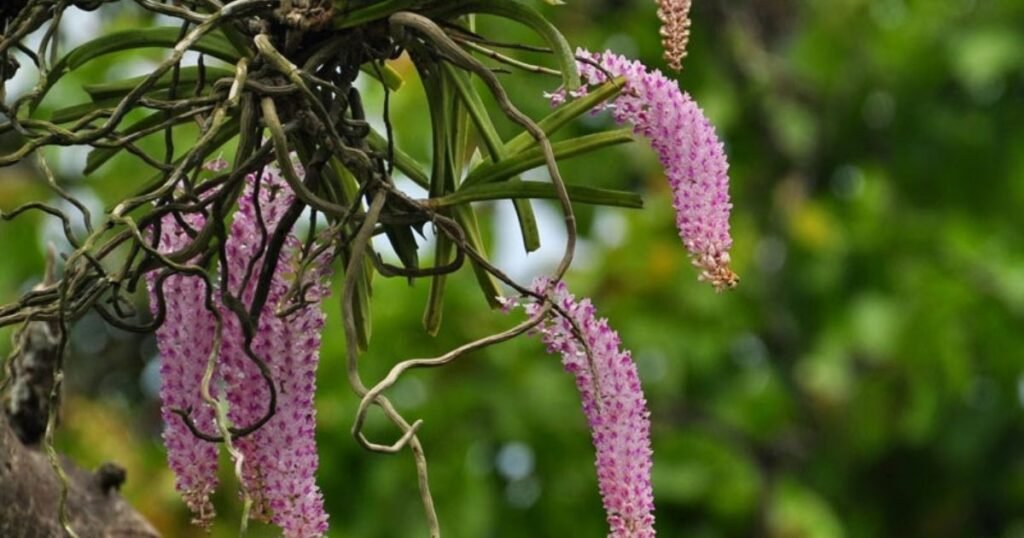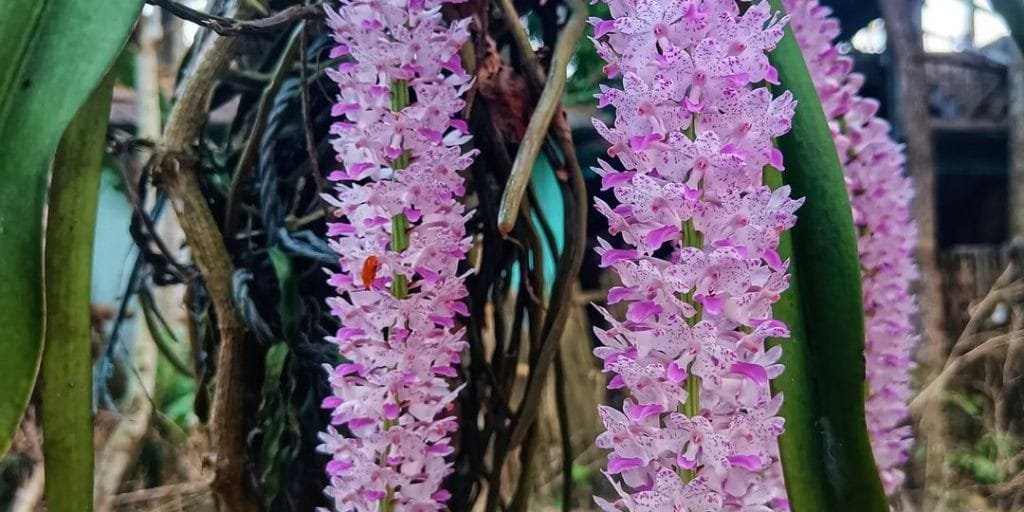
The Foxtail Orchid is an attractive pinkish-white or purplish-white variant found in Asia. It is found in the wild, but many people prefer growing in their homes because of its distinct appearance. It is a hybrid plant that can be easily grown with proper care and nourishment.
In India, it is found in Assam and Arunachal Pradesh. It is even categorized as the state flower of the following states. Natives of Assam and Arunachal Pradesh have great sentiments related to Foxtail Orchid.
Important Facts About Foxtail Orchid
The Foxtail orchid is found in the Asian continent. It is a variant amongst the 28,000 species available all over the world. It is a hybrid form of orchid that grows in the wilds of India. Orchid lovers do love this variant and are capable of growing it in their homes.
The fact behind naming it ‘Foxtail Orchid’ is its appearance. The Foxtail orchid resembles the appearance of a fox’s tail. Thus, it was named after it. Its trails fall in the downward position with a pointed tip.
| Scientific Name | Rhynchostylis Retusa |
| Availability | Assam, Arunachal Pradesh, Orissa, and Andhra Pradesh |
| Blooming Season | April-May |
| Temperature | A moderate temperature between 10–30°C |
| Watering | Twice a week |
| Pet Friendly | Yes |
Significance of Foxtail Orchid
Cultural Significance

Unlike any other orchids, Foxtail orchids hold a special connection with North-East India. It has been announced as the state flower of Assam and Arunachal Pradesh. Of course, because of its abundant amount of availability in this region.
In Assam, the Foxtail orchid is known as the Kapau phool. Its blooming resembles the welcome of the Assamese New Year or Bohag Bihu in April. The Assamese women are fond of it, and it is used as a decorative garland around their hair buns. In short, it is a traditional culture that has been following over the years.
On the other hand, In Arunachal Pradesh, it symbolizes joy and fertility. It is quite popular during the spring season.
Medicinal Properties

Many people are unaware but Rhynchostylis Retusa carries a lot of medicinal properties. It was quite popular in the past. This plant to treat rheumatism, skin diseases, malaria fever, allergies, and eye problems. Because of its anti-inflammatory properties, it works great in such diseases. The parts that are used are its flowers, roots, and leaves.
Improvement of Air Quality

Foxtail orchids can help to elevate the air quality both indoors and outdoors. It allows them to settle down the toxins and consume the freshness of clean air. Indeed it helps in managing stress and promotes tranquility with one another. Air cleansing and healing with a stress-free life is best.
Attractive Appearance

This beautiful growing orchid is the simplest yet attractive looking orchid. Its appearance resembles luxury in the most low-key way. It can be placed in an outdoor setup where you can grow naturally. While indoors you can set the plant in a glass bottle. The best is to keep it near the window to receive sunlight to remain fresh.
Best Way to Take Care and Grow Foxtail Orchid – Rhynchostylis Retusa
Growing Rhynchostylis Retusa
It isn’t a difficult task to grow Rhynchostylis Retusa. The best way to grow is in its wild and natural habitat. Generally, it is grown outdoors where it receives the right amount of sunlight and water. Foxtail orchids are epiphytic plants and grow in the trunks of the trees. The warm tropical climate is the best for it. These do not go well with direct sunlight since it can be harsh for them. While they love bright yet draped sunlight. Indoors during the fall and winter seasons, it can adjust itself to brighter light.
If we have to talk about its soil requirement, then we say that it does well in a clay pot with a good draining system. Even wooden baskets with chunky bark or lava rocks help them to grow easily. It is a steady-growing plant that hates to be disturbed again and again. Indeed frequent repotting should be banned at least for 5-6 years. To know about its repotting check whether the plants have grown from the sides of the container or not.
The Foxtail orchid is a delicate plant to grow but not a difficult one. So, with proper care and love, you can surely have these in your home.
Taking Care of Rhynchostylis Retusa
1. Rhynchostylis Retusa grows best in humid regions. The humidity level in Assam, Arunachal Pradesh, Orissa, and Andhra Pradesh is high. Therefore, it is suitable for cultivating this orchid. In Indoors because of lower humidity, it is asked to mist or water the orchids daily. But overwatering is strictly prohibited.
2. Foxtail orchid is delicate so make sure the soil or the medium used for it is not soggy or moistured all the time. A proper drainage system should be done for the roots to get enough oxygen flow. Otherwise, root rot can hamper its overall growth.
3. Not too cold nor too hot water should be used to water Foxtail orchid. Lukewarm water is preferably best. After watering make sure the water is drained. At least 15 minutes of draining before transferring it to the drainage saucer.
4. This orchid should be fed with NPK fertilizer with a ratio of 20-20-20. Don’t overfeed as it can be harmful to the plant.
The Foxtail orchid is unique and is famous for its quirky look. This beautiful plant grows in Eastern areas of India where the humidity levels are up. The Foxtail orchid makes a great plant for cultivation. To check out some great deals you can kindly click on the following link Plantzone.
FAQs
Does Foxtail Orchid have any fragrance?
Ans: Yes, Foxtail Orchid does have a strong fragrance. You can distinctively smell the scent when the temperature is warm.
How many days do flowers on the Foxtail orchid last in its blooming season?
Ans: The Orchid flowers on the Foxtail orchids can stay alive for a minimum of two weeks or longer.
Name the common and dangerous pests and diseases that can affect Foxtail Orchid.
Ans: A few pests and diseases that are common are Orchid viruses, black rot, bult rot, mealy bugs, and scale insects.














